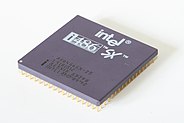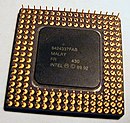i486SX
i486SX — микропроцессор, первоначально выпущенный Intel в 1991 году. Это был модифицированный микропроцессор Intel i486DX с отключенным модулем вычислений с плавающей запятой (FPU) . Он был задуман как более дешевый процессор для использования в недорогих системах (продаваемый по цене 258 долларов США) с адаптацией суффикса SX более раннего i386SX , чтобы обозначить более дешевый вариант. Однако, в отличие от i386SX, который имел 16-битную внешнюю шину данных и 24-битную внешнюю адресную шину (по сравнению с полностью 32-битным i386 DX, его более дорогим аналогом), i486SX был полностью 32-битным. [1] : 117
Обзор [ править ]
В начале 1990-х годов распространенные приложения, такие как текстовые процессоры и приложения баз данных, не нуждались в модулях с плавающей запятой или не нуждались в них, например, включенном в i486 , представленный в 1989 году. Среди редких исключений были приложения САПР , которые могли часто моделируют операции с плавающей запятой в программном обеспечении, но получают огромную пользу от аппаратного модуля с плавающей запятой. [2] AMD начала производство своего i386DX клона , Am386 , который был быстрее, чем у Intel. [3] Чтобы отреагировать на эту новую ситуацию, Intel хотела предоставить системным интеграторам более дешевый процессор i486 , но не жертвуя при этом большей прибылью от полноценного i486. Intel смогла добиться этого с помощью i486SX, первые версии которого были практически идентичны i486, но с внутренним блоком вычислений с плавающей запятой, который отключался. [1] : 116–117 [4] : 162–164 [а] i486SX был представлен в середине 1991 года с частотой 20 МГц, одним ядром и 8 КБ кэш-памяти в корпусе с массивом выводов (PGA) . [2] Существовали маломощные версии микропроцессоров Intel486 SX с частотой 16, 20 и 25 МГц. Они были доступны по цене 235, 266 и 366 долларов США для этого диапазона частот соответственно. Все цены указаны для количества от 1000 штук. [6] В более поздних версиях i486SX, начиная с 1992 года, из соображений экономии полностью удален FPU, и они также поставляются в корпусах для поверхностного монтажа. [1] : 117
Первой компьютерной системой, поставляемой с завода с i486SX на материнской плате, была Advanced Logic Research в апреле 1991 года. Business VEISA 486/20SX компании [7] Первоначальные отзывы о чипе i486SX среди технических изданий и покупателей в целом были плохими, поскольку они считали его примером вредоносного ПО . [1] : 117
Многие системы позволяли пользователю обновить i486SX до ЦП с включенным FPU. Обновление поставлялось как i487 , который представлял собой полноценный чип i486DX с дополнительным выводом. Дополнительный контакт предотвращает неправильную установку чипа. [б] Хотя устройства i486SX вообще не использовались при установке i487, их было трудно удалить, поскольку i486SX обычно устанавливался в разъемы, отличные от ZIF , или в пластиковый корпус, который монтировался на поверхность материнской платы. Более поздние процессоры OverDrive также подключались к разъему и также предлагали повышение производительности. [8]
Пояснительные примечания [ править ]
- ↑ Давно ходили слухи, что первые партии i486SX представляли собой чипы i486 с дефектными модулями операций с плавающей запятой на кристаллах. Однако Алекс Витковски, выпускник Intel и инженер i486SX, опроверг это в блоге OS/2 Museum , написав, что блоки с плавающей запятой оригинального чипа i486, подлежащие преобразованию в i486SX, никогда не тестировались, и это только это преобразование было выполнено путем заземления определенного соединительного провода в корпусе ЦП . [5]
- ^ Контакт NC# (один из 168 стандартных контактов i486) использовался для отключения i486SX. [5]
Ссылки [ править ]
- ^ Jump up to: Перейти обратно: а б с д Росс, Мэтью Дж. (13 октября 1992 г.). «486SX: Новый ПК начального уровня» . Журнал ПК . 11 (17). Зифф-Дэвис: 114–257.
- ^ Jump up to: Перейти обратно: а б Слейтер, Майкл (июль 1991 г.). «Новая платформа начального уровня: Intel планирует, что 486SX постепенно заменит 386DX» . Компьютерный покупатель . 11 (7). SX2 Media Labs: 113 – через Гейла.
- ^ Кэрон, Иеремия (20 мая 1991 г.). «Больше удара на каждый потраченный доллар» . Компьютерный мир . XXV (20). Публикации IDG: 104 – через Google Книги.
- ^ Сеймур, Джим (31 декабря 1991 г.). «486SX: отлично подходит для Intel, а как насчет вас?» . Журнал ПК . 10 (22). Зифф-Дэвис: 170–238 – через Google Книги.
- ^ Jump up to: Перейти обратно: а б Некасек, Михал (26 декабря 2015 г.). «Ложь, наглая ложь и Arc.Ask3.Ru» . Музей OS/2 . Проверено 27 декабря 2015 г.
- ^ Корпорация Intel, «Новый продукт: компоненты: модифицированные чипы сокращают энергопотребление портативных компьютеров», Microcomputer Solutions, ноябрь/декабрь 1991 г., стр. 10
- ^ Лавин, Пол (24 апреля 1991 г.). «Первый в мире 486SX» . Пользователь ПК (157). EMAP Media: 33 – через Гейла.
- ^ «Типы и характеристики микропроцессоров» . ИнформИТ . Пирсон. 8 июня 2001 г. Архивировано из оригинала 7 декабря 2021 г.
Внешние ссылки [ править ]
- Изображения и описания Intel 80486SX на сайте cpu-collection.de
- Таблицы данных Intel



